Road races in the 1950s in the UK were very different from today’s races. Most races were over 10 miles and distances varied. The only standard distances were 20 miles and the marathon.
Petrol rationing ended in 1950 but the number of vehicles on the road was tenth of today’s traffic. This meant that point to point races along main routes were possible, including point to point relays.
Road running was a niche sport. In 2019, tens of thousands of people completed a marathon in the UK. In 1959, it was less than one thousand.
Road running was a sport for men. Women were limited to running up to 1 mile on the track and up to 3 miles in cross country, with occasional races of up to 4-and-a-half-miles at cross country meetings.
There was a widely held view that distance running was too strenuous for women and could irreparably harm their reproductive health. It was not until the late 1970s that road races began to admit women, following changes in the governing bodies’ rules.
There were separate men’s and women’s Amateur Athletics Associations (AAAs) in each home nation. Competition was strictly segregated. Some athletics clubs admitted both men and women. There were lots of women’s clubs. They were sometimes set up as a result of frustration at the limited opportunities for coaching and races offered to women in mixed clubs.
The athletics governing bodies were focused on track and field and cross country. The English Women’s AAA saw part of its role as protecting women from potential harm and this meant they had no interest in promoting road running for women, and indeed actively opposed it. The men’s AAAs’ remit included road running but they did not arrange championships, with the exception of the marathon – the English, Scottish and Welsh AAAs all had a Marathon Championship in the 1950s.
English road races in the 1950s
The Polytechnic Harriers Marathon, usually called the Poly Marathon, was the biggest marathon in the UK and the most well-known, attracting runners from other countries. It started in 1909, the year after the London Olympics, and was held most years until 1996. It was the first marathon to be run regularly over the distance of 26 miles 385 yards. Women were first admitted to the race in 1978. The route varied considerably over the years but always started in Windsor, as the Olympic marathon had, and often ended in Chiswick. The 1950s were part of the heyday of the Poly Marathon as British runner Jim Peters broke the world record three times.
- 1952 Jim Peters – 2:20:42:2
- 1953 Jim Peters – 2:18:40:4
- 1954 Jim Peters – 2:17:39:4
Jim Peters breaking the world record at the Polytechnic Marathon on 14th June, 1952. (Photo by Ed Lacey/Popperfoto via Getty Images/Getty Images)
The Poly Marathon remains one of the longest running marathons in the world. It was not, however, the longest running race in the UK at that time. That distinction went to the Morpeth to Newcastle race which was established in 1904. Originally 13.6 miles, it was run on New Year’s Day every year until 2001, only stopping for the two World Wars and once being postponed by two weeks because of snow in 1979. It was run as a half marathon on the second Sunday in January from 2002-2004. Women competed for the first time in 1982.
The most popular distances in England appear to have been 20 miles and the marathon, but there were shorter and longer distances too. There were several 20-mile races to choose from, especially if you lived in the South East of England and some of these were county championships. The most popular distances today, 10ks and half marathons, didn’t exist in the 1950s.
A popular shorter distance race was the Brampton to Carlisle. Organised by Border Harriers & Athletic Club, the original distance was eight and a half miles but after five years this was extended to 10 miles. Border Harriers state that it is the longest-running 10 mile race in the UK. 2020 would have marked the 69th edition of the race. Women competed for the first time in 1979.
The number of runners in each race was small. For example, the Kent 20 in May 1953 had 48 men start, 41 of whom finished, and 119 men finished the Poly Marathon in June that year. In the 1958 Peterborough Marathon, 96 entered, 67 started and 44 men finished on a very hot day.
A 1956 preview of the elite runners in that year’s Poly Marathon in June mentions competitors having taken part in the following races in the lead-up:
- Morpeth to Newcastle
- Notts 15
- Wigmore 15
- Chichester to Portsmouth 16
- Finchley 20
- Kent 20
- Southern 20
- Surrey 20
- Hertfordshire 20
- Liverpool to Pembroke 20
- Doncaster to Sheffield Marathon
- Hull Marathon
- Peterborough Marathon
The Finchley 20 is one of the UK’s longest-running road races. It was started in 1933 by Finchley Harriers. The Harriers amalgamated with Ruislip and Northwood AC in 1966 becoming Hillingdon AC. The race has continued until the present day but is now called the Hillingdon 20. It was last held in March 2020. Women did not compete in the Finchley 20 until 1987.
1950s Marathons in the UK
A 1984 Road Runners Club UK newsletter states that in 1959 there were just twelve marathons in the UK. Given that the Poly Marathon only had 128 finishers that year, it’s likely that fewer than 1,000 men finished a marathon in 1959.
The twelve marathons in 1959 included:
- Poly Marathon
- Doncaster to Sheffield Marathon
- Hull Marathon
- Peterborough Marathon
- Liverpool Marathon
- Isle of Wight Marathon
- Watford Marathon
- Belfast Marathon
- Scottish AAA Championship Marathon
The Doncaster to Sheffield Marathon, sometimes referred to as the Sheffield Marathon, began in 1929 and ran until 2003 with two long breaks from 1932-1945 and 1962-1981. In the 1940s and 1950s, the route was a 6-mile loop from Doncaster to Sheffield. Women competed for the first time in 1982.
The Hull Marathon ran from 1953 to 1969.
The Peterborough Marathon was organised by the Brotherhood Works Sports Club. Brotherhood Ltd was a large engineering company with a long history in the town. In the post-war period an annual Sport and Gala Day was organised on Whitsun Monday. This included athletics competitions. The marathon was run in 1949 and may have started that year or the year before. It was run throughout the 1950s with two exceptions: 1953, when it was cancelled because of work for the coronation of Queen Elizabeth II, and 1957, when it clashed with an inter-counties 20 mile race. The course was a flat 9-mile loop. In 1958, to get a “time standard” medal men had to finish in 3 hours. The organizer commented that he was thinking of lowering the time as performances were improving.
The Liverpool Marathon started in 1927, took place for four years then wasn’t held from 1931 to 1947. It took place throughout the 1950s.
The Isle of Wight Marathon was set up by Ryde Harriers in 1957 and has taken place every year since in May. 2020 would have been its 64th event. Women were admitted to the race in 1976, but in 1964 Ryde Harriers allowed Dale Greig to run the race as a time trial. Her time was subsequently recognised by World Athletics as a world best.
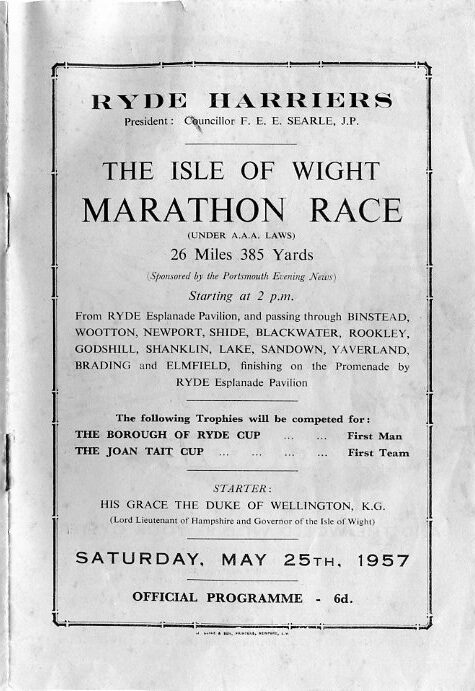
The Watford Marathon hosted the AAA Championship in 1959. It had also been the championship race in 1957.
The Belfast Marathon started in 1946 and is still going today, making it one of the ten longest-running marathons in the world. Women first competed in 1982.
The route of the Scottish AAA Championship Marathon in 1959 was from Falkirk to Edinburgh finishing at the Meadowbank Stadium.
Scottish road races in the 1950s
Unusually for the 1950s, the Scottish classic distance races include a shorter distance race, the Nigel Barge 4¾ miles. Organised by Maryhill Harriers, the race commemorated a young engineer killed in action at the age of 23 in Dunkirk during World War II. It was always held on the first Saturday of January, unless it fell on New Year’s Day in which case it was deferred by a week. It was first run in 1943 and attracted Scotland’s top runners. It is still held today but is now a 10k.
Another classic race was the Perth to Dundee 22-mile race, another event which started during wartime. It was held from 1942 to 1954. The route followed the main highway from Perth to Dundee and petrol rationing, which lasted from 1942 to 1950, meant that there was much less traffic on the road. It was the increase in traffic which forced the race to stop.
One of the oldest road races in Scotland is the Balloch to Clydebank race first held on 31st March 1928. The race was described as “a marathon race of 12 miles“. It was organised by Clydesdale Harriers for the four local clubs then Dunbartonshire AAA took over. The race is still held every year in March and took place in 2020. It became an open event in the 1970s and in 2000 the course was extended to a half marathon.
The Scots Athlete magazine published from 1946-1958 by Walter Ross, a Glasgow printer and publisher, lists several other road races, most between 12 and 18 miles in distance. The 20-miler does not seem to have had the same popularity in Scotland as it did in England. The Scots Athlete fixtures lists included:
- Clydebank to Helensburgh 16 miles
- Vale of Leven 14 miles
- Post Office Telephones Helenvale 15 miles
- Maryhill Harriers Dunoon 12 miles
- Carluke 11 miles
- Saxone AAC Kilmarnock 18 miles
The fixtures lists suggest that there may have been five or six races each month from May to August.
The Clydebank to Helensburgh 16 miles started in 1950 as a New Year’s Day race. In 1951 it was organised by Dunbartonshire AAA and 24 runners competed in a snow storm which had turned to sleet by the end. At some point in the 1950s the Scottish Marathon Club took over the organisation of the race and it moved to a late April date. The Scottish Marathon Club was still organising the race in 1982.
The Edinburgh to North Berwick race started in 1958 and has been held almost continuously since. 2020 would have marked the 60th edition of the event. Originally it was run from North Berwick to Edinburgh. The distance was 22.6 miles. In 1971-73 and 1991 it was extended to marathon distance. In 2009 it became a 20 mile race and is now organised by Edinburgh Athletic Club.
Races were often put on as part of Highland Games events held in the summer months. The 1955 Edinburgh Highland Games included an Edinburgh Festival Trophy Marathon.
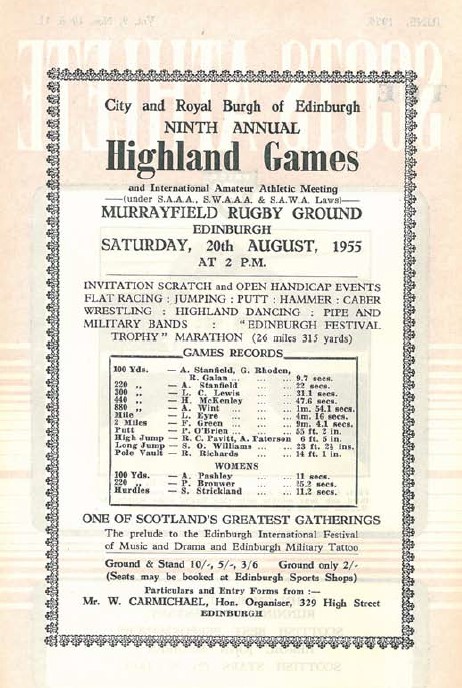
At the start of the decade, the Scottish Marathon Club championships consisted of four races: Clydebank to Helensburgh 16; Springburn Harriers Bishopbriggs 12 miles; Strathallan 20 miles; the SAAA Marathon Championship.
The Scottish Marathon Club (1944-1995) was founded to promote marathon running in Scotland. One of its key aims was to bring pressure on the SAAA to hold a Marathon Championship each year. The first SAAA Championship Marathon was held in 1946 and a championship race was held every year during the 1950s. Most of these marathons finished at the Meadowbank Stadium in Edinburgh and were run alongside the Track and Field Championships. The exceptions were: 1951 Symington to Hampden Park (Glasgow); 1952 Perth to Dundee (a longer version of the classic race); 1954 Gourock to Glasgow as part of the Glasgow Highland Games.
The Edinburgh to Glasgow Relay was the premier road race of the post-war period. It was described as the unofficial road relay championships of Scotland. It was held from 1930 to 2002 when it was discontinued due to traffic problems. The Scottish distance running history website states that Trudi Thomson was the only woman to compete in the race when she ran the fourth leg for Pitreavie AAC in 1998.
The relay was sponsored by The News of the World newspaper which also sponsored the London to Brighton road relay (held 1925-1965). There was also a Manchester to Blackpool inter-city relay.
The distance of 45 miles was split into eight legs of between 5 and 7 miles. The top 20 clubs in Scotland were invited to take part and there was fierce rivalry between them. In the 1950s, Victoria Park AAC dominated, winning seven times, finishing second once and third twice.
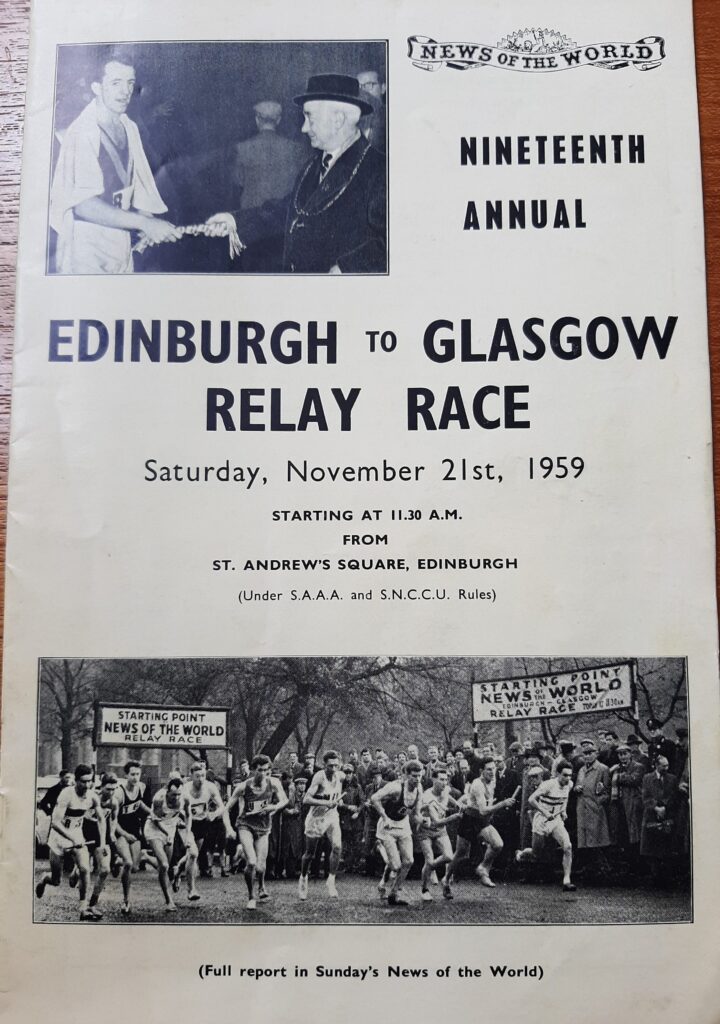
Another popular and long-running relay race was the McAndrew Road Relay first organised by Victoria Park AAC in 1934. It was held on the first Saturday in October and marked the start of the winter season for many of the top club runners. The relay consisted of four runners each completing a lap of about three and a quarter miles. In the 1980s it attracted as many as 150 teams. Its 75th edition in 2014 was also the last. According to an article in The Herald, the police’s reluctance to stop traffic was part of the reason for the race’s discontinuation. Ironically, this was related to complaints from the public following road closures for the Glasgow Commonwealth Games in 2014.
Welsh road races in the 1950s
I have not found many records of Welsh road races. The Welsh Amateur Athletics Association had a men’s Marathon Championship and in 1950 it was held as part of the Steel Company of Wales’ open meeting at Margam. There was a Cardiff Marathon in 1953 which served as the English AAA Championship.
The Newport 10 mile race started in 1958 and was held until 2001.
The Nos Galan 5k Road Races in Mountain Ash also started in 1958. They celebrated the life and achievements of Welsh runner Guto Nyth Brân. They were held on New Year’s Eve until 1973 and timed to end at midnight. The races even featured in the BBC’s New Year’s Eve programming. Police concerns about traffic delays led to be them being cancelled. Resurrected in 1984, the races are still being held and are a very popular event, attracting thousands of spectators.
Races longer than a marathon in the 1950s
Races that were longer than a marathon were not differentiated from the shorter distances. The term “ultra distance” was not used. John Emmet Farrell refers to them as “the extra-staying events” in his commentary in The Scots Athlete magazine.
The South London Harriers 30 was held from 1943 to 1991 and the club’s website states that it was the only road race of that distance in the UK.
London to Brighton started in 1951, the year of the Festival of Britain. It was organised by the Road Runners Club (UK) for many years from 1952.
The club had been set up that year and did much to promote road running and ultrarunning in the UK.
The race was started at Big Ben, Westminster, and finished at the Aquarium in Brighton. There were route changes over the years. In the 1950s the course was between 52 and 53 miles long. The race started to build a reputation and from 1953 it attracted runners from South Africa and the USA.
There were around 50 competitors each year. They had to meet a qualifying standard and the time limit was 8 hours 15 minutes. Dale Greig participated unofficially in 1972, running the race as a time trial, starting one hour before the men. In 1979, three women: Leslie Watson and Lydia Kirk of Great Britain and Ruth Anderson of the USA ran the race unofficially. The following year women were finally admitted. The race was held until 2005.
25th September 1953: South African Wally Hayward winning the London to Brighton road race in 5 hours 29 mins. (Photo by J. A. Hampton/Topical Press Agency/Getty Images)
Isle of Man 40 started in 1955 and was held every year until 1986, and six times in the 1990s with the last race in 1996. The route followed the TT (time trial motorbike race) course and was 37.75 miles but was lengthened in the 1960s to around 40 miles. Dale Greig was the first woman to run the race in 1971, but women did not officially compete until 1982.
Ad-hoc events were organised, often with just a handful of men taking part. For example, the Road Runners Club newsletter from October 1953 announced plans for “an attempt on the Bath Road 100 mile record” to be organised by the club with sponsorship from the News of the World newspaper. Two South African runners who had competed in London to Brighton the previous month, Wally Hayward and Jackie Mekler, were down to run along with Blackheath Harriers runner Derek Reynolds and perhaps two others. Hayward had won London to Brighton, Mekler and Reynolds had finished fourth and fifth. The event started on Saturday 24th October and Hayward broke the record for the route with a time of 12 hours 20 minutes 28 seconds.
Where were the women?
Was a woman’s place in the home in the 1950s? If she was a runner, she might compete at track and field events and cross country into her twenties, but most women had no opportunity to run further than 3 miles. It was fairly common for even elite female athletes to retire from competition in their early twenties or when they got married. The average age for women to marry was around 26 and only around a third of women of working age were in employment in 1951.
It has been interesting and engrossing to research the history of all the races in this article. But this research highlights all the opportunities that women did not have in the 1950s, 1960s and 1970s. For example, what might Diane Leather, the first woman to run a sub-5-minute mile (1954) and four-times national cross country champion (1953-56), have achieved if she had had the opportunity to race over longer distances on the road?
Diane Leather leads the field during a race, at White City stadium, London, August 3rd 1957. (Photo by Ed Lacey/Popperfoto via Getty Images/Getty Images)
Road running offered some men the chance to carry on running competitively past their twenties. Jim Peters was 33 when he set his first world record at the Polytechnic Marathon.
This research leads to the following questions:
- Were there any women’s road races in the 1950s?
- Did some of the women’s clubs put road races on?
- Did women ever train on the road?
- Did any women “crash” road races, running unofficially to prove that women could cover the distance?
- Were there female ghostrunners – women who race organisers permitted to run but who then were missed from the results?
I would be very interested to hear from anyone who can answer any of these questions.
There are bound to be some gaps in this article. I have not found much information about road running in Wales and I have not researched Northern Ireland. I’ve found nine UK marathons held in 1959 but believe there were twelve. I’ve come across mentions of lots of Scottish races but am not sure which ones were held throughout the 1950s. If you can help with any of these gaps, please do comment on this article.
…………………………………………….
With thanks to Doug Milsom, Hamish Robertson and my father, Terry Holmes, for sharing their experience of racing in the 1950s. Also thanks to Hugh Barrow and Colin Youngson for signposting me to additional information on Scottish races.
Other articles:
Diane Leather and the 5 minute mile
Milestones in women’s marathon history – 1964 – Dale Greig, Playing Pasts website, May 2020
Sources:
Road Runners Club newsletter, December 1952 – January 1954
The Scots Athlete, January 1950 – June 1958, downloaded from Scottish Athletics Road Running and Cross Country Commission archive website
Road Runners Club newsletter, April 1984
Association of Road Racing Statisticians (ARRS) results listings
British road race championships, gbrathletics.com website
Kingston & Polytechnic Harriers AC website – The Polytechnic Marathon – A short history
The Polytechnic Marathon 1909–1996, Ian Ridpath, ianridpath.com
“Morpeth Harriers forced to cancel new year race”, Northumberland Gazette, 3rd December 2019
Brampton to Carlise 10 Mile Road Race, Border Harriers website (accessed 10th October 2020)
Hillingdon AC website, club history
“44 finish marathon in gruelling conditions”, Peterborough Advertiser, 22nd July 1958
Ryde Harriers website, photos – marathon memorabilia
Maryhill Harriers website, Nigel Barge road race history
“A Hardy Race – the Scottish Marathon Championship 1946 to 2000 and the Scottish Women’s Championship 1983 to 2000”, Fraser Clyne and Colin Youngson
The Classics, Scottish Distance Running History website (accessed 10th October 2020)
Balloch to Clydebank – History, Dunbartonshire AAA website (accessed 10th October 2020)
Clydebank to Helensburgh Road Race, The Coatbridge Leader, 4th January 1951 (accessed via the British Newspaper Archive 10th October 2020)
“End of the Road for the McAndrew Relay shows a sport in crisis”, The Herald, 26th September 2015 (accessed 10th October 2020)
History of Nos Galan, Rhondda Cynan Taf Borough Council website
Road Running Championships, Athletics Stats Wales website.
DUV Ultramarathon Statistics website
South London Harriers website, SLH History
“The history of the London to Brighton race”, Andy Milroy, Blackheath and Bromley Harriers AC website, originally published in 1998 on Ultramarathon World website which no longer exists.
“Bath to London record by Hayward”, The People, 25th October 1983.
Transport Statistics Great Britain 2018 Roads and Traffic & Vehicles, Department of Transport
UK marriage and employment statistics, Office for National Statistics
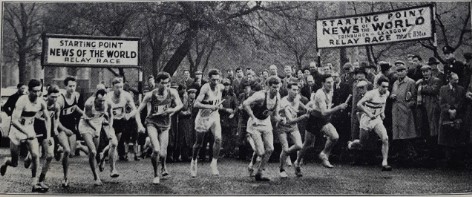
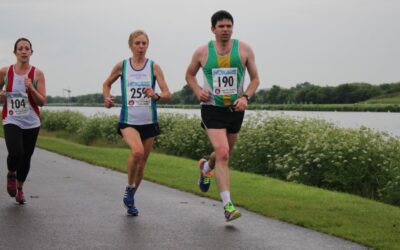
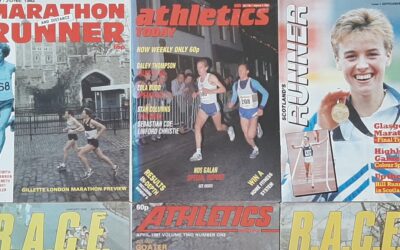
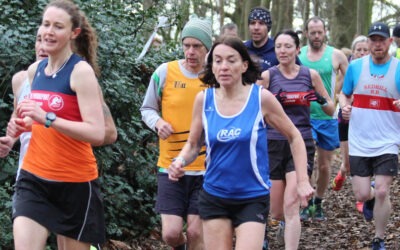
0 Comments